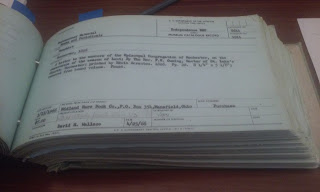This week was a
catch-up game with data entry. Over the last two weeks, the IT team here
at INDE was working on migrating the outdated server to Windows 7. Thus, the
cataloging system ICMS has been down while IT works on moving all of the
records to the new server. At the several museums and archives I’ve worked in
throughout the years, I’ve learned the importance of having reliable technology
to ensure that all data pertaining to the institution and the artifacts
themselves kept safe. It’s
important that the data and information pertaining to artifacts be maintained
and preserved with the same care that that we give to physical artifacts.
While this was happening, I finished polishing the silver this week, which
I asked my coworker to inspect. (I passed with flying colors!) Once ICMS was up
and running, I spent most of my week doing data entry. As I worked in
the Second Bank for the first few weeks, I didn’t have access to the
catalog records, so I wasn’t always sure of the history behind the individual
artifacts I was treating. In working with the online catalog, however, I’ve
gotten to enter data for the objects in the Second Bank and learn more about
the collections here. For example, I noticed in my first few weeks that
there was a set of hinges in one of the storage rooms in the Second bank. When
I searched the number later on, the description revealed that these were the
original 1750s hinges from the guard room door in the Independence Hall
Tower Stair Hall! Looking through the catalog is a nice chance to learn about
the kinds of objects in INDE’s collection, as well as the particulars of when
and how they were acquired.
Many of the catalog records were cataloged anywhere between the early 1950s and
the present, but most of the objects I’ve worked on were cataloged between the
1960s and 1980s. Some of the information in the catalog books wasn’t completely
transferred to the computer database, so I’m working on entering information
that labels the object’s description, origin, market value, measurements,
condition report, location, etc., just to name a few. Karie explained to me
that this is a project that has been in the works for quite some time, so
having me here is a way to catch up with all of the work. Without an organized
and standardized system, it would be impossible to manage INDE’s 2.5 million
objects.
 |
 |
| Shelves of the paper catalogs for all historic objects at INDE. |
 |
| On-line cataloging system. |

No comments:
Post a Comment